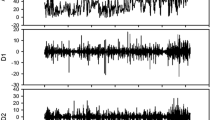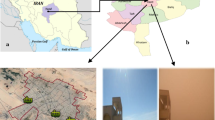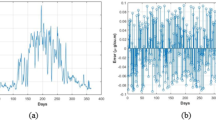Abstract
The present paper proposes a wavelet based recurrent neural network model to forecast one step ahead hourly, daily mean and daily maximum concentrations of ambient CO, NO2, NO, O3, SO2 and PM2.5 — the most prevalent air pollutants in urban atmosphere. The time series of each air pollutant has been decomposed into different time-scale components using maximum overlap wavelet transform (MODWT). These time-scale components were made to pass through Elman network. The number of nodes in the network was decided on the basis of the strength (power) of the corresponding input signals. The wavelet network model was then used to obtain one-step ahead forecasts for a period extending from January 2009 to June 2010. The model results for out of sample forecast are reasonably good in terms of model performance parameters such as mean absolute error (MAE), mean absolute percentage error (MAPE), root mean square error (RMSE), normalized mean absolute error (NMSE), index of agreement (IOA) and standard average error (SAE). The MAPE values for daily maximum concentrations of CO, NO2, NO, O3, SO2 and PM2.5 were found to be 9.5%, 17.37%, 21.20%, 13.79%, 17.77% and 11.94%, respectively, at ITO, Delhi, India. Bearing in mind that the forecasts are for daily maximum concentrations tested over a long validation period, the forecast performance of the model may be considered as reasonably good. The model results demonstrate that a judicious selection of wavelet network design may be employed successfully for air quality forecasting.






















Similar content being viewed by others

References
Aquino, V. A., Trevino, E. S. G., Romero, R. R., Cruz, J. F. R., Ojeda, G. G., & Asomoza, J. R. (2005). Wavelet-network based on L1-norm minimization for learning chaotic time series. Journal of Applied Research and Technology, 3, 211–221.
Bruce, A. G., & Goa, H.-Y. (1996). Understanding waveShrink: variance and bias estimation. Biometrika, 83, 727–745.
Chaloulakou, A., Saisana, M., & Spyrellis, N. (2003). Comparative assessment of neural networks and regression models for forecasting summertime ozone in Athens. Science of the Total Environment, 313, 1–13.
Chelani, A. B., Chalapati Rao, C. V., Phadke, K. M., & Hasan, M. Z. (2002). Prediction of sulphur dioxide concentration using artificial neural networks. Environmental Modelling and Software, 17, 161–168.
Chelani, A. B., & Devotta, S. (2007). Air quality assessment in Delhi: Before and after CNG as fuel. Environmental Monitoring and Assessment, 125, 257–263.
Cogliani, E. (2001). Air pollution forecast in cities by an air pollution index highly correlated with meteorological variables. Atmospheric Environment, 35, 2871–2877.
Cornish, C. (2006). The WMTSA wavelet toolkit for MATLAB. http://www.atmos.washington.edu/~wmtsa/.
Coulibaly, P., Anctil, F., Aravena, R., & Bobee, B. (2001). Artificial neural network modeling of water table depth fluctuations. Water Resources Research, 37(4), 885–896.
Elkamel, A., Abdul-Wahab, S., Bouhamra, W., & Alper, E. (2001). Measurements and prediction of ozone levels around a heavily industrialized area: A neural network approach. Advances in Environmental Research, 5, 47–59.
Elman, J. L. (1991). Distributed representations, simple recurrent networks, and grammatical structure. Machine Learning, 7, 195–224.
Galvao, R. K. H., & Yoneyama, T. (2004). A competitive neural network for signal clustering. IEEE Transactions on Systems, Man, and Cybernetics. Part B, Cybernetics, 34, 1282–1288.
Gardner, M. W., & Dorling, S. R. (1998). Artificial neural network (the multi layer perception)—a review of applications in the atmospheric sciences. Atmospheric Environment, 32, 2627–2636.
Gautam, A. K., Chelani, A. B., Jain, V. K., & Devotta, S. (2008). A new scheme to predict chaotic time series of air pollutant concentrations using artificial neural network and nearest neighbor searching. Atmospheric Environment, 42, 4409–4417.
Gokhale, S., & Khare, M. (2007). Statistical behaviour of carbon monoxide from vehicular exhausts in urban environment. Environment Modeling and Software, 22, 526–535.
Goyal, P., & Rama Krishna, T. V. B. P. S. (1998). Various methods of emission estimation of vehicular exhausts in urban environment. Environment Modeling and Software, 22, 526–535.
Grinsted, A., Moore, J. C., & Jevrejeva, S. (2004). Application of the cross wavelet transform and wavelet coherence to geophysical time series. Nonlinear Processes in Geophysics, 11, 561–566.
Hardle, W., Kerkyacharian, G., Picard, D., & Tsybakov, A. (1998). Wavelets, approximation, and Statistical applications (Lecture Notes in Statistics, vol 129). New York: Springer.
Ho, S. L., Xie, M., & Goh, T. N. (2002). A comparative study of neural network and Box–Jenkins ARIMA modeling in time series prediction. Computers and Industrial Engineering, 42, 371–375.
Hogrefe, C., Vempaty, S., Rao, S. T., & Porter, P. S. (2003). A comparison of four techniques for separating different time scales in atmospheric variables. Atmospheric Environment, 37, 313–325.
Hogrefe, C., Biswas, J., Lynn, B. H., Civerolo, K., Ku, J. Y., Rosenthal, J., Rosenzweig, C., Goldberg, R., & Kinney, P. (2004). Simulating regional-scale ozone climatology over the eastern United States: model evaluation results. Atmospheric Environment, 38, 2627–2638.
Iyengar, S. S., Cho, E. C., & Phoha, V. V. (2002). Foundations of wavelet networks and applications. USA: Chapman & Hall, CRC.
Kaastra, I., & Boyd, M. (1996). Designing a neural network for forecasting financial and economic time series. Neurocomputing, 10, 215–236.
Karppinen, A., Kukkonen, J., Elolähde, T., Konttinen, M., Koskentalo, T., & Rantakrans, E. (2000). A modelling system for predicting urban air pollution: Model description and applications in the Helsinki metropolitan area. Atmospheric Environment, 34, 3723–3733.
Kumar, U., Prakash, A., & Jain, V. K. (2008). Characterization of chaos in air pollutants: A Volterra–Wiener–Korenberg series and numerical titration approach. Atmospheric Environment, 42, 1537–1551.
Lau, K.-M., & Weng, H. (1995). Climate signal detection using wavelet transform: How to make a time series sing. Bulletin of the American Meteorological Society, 76, 2391–2402.
Lin, C.-H., & Wu, Y.-L. (2003). Semi-statistical model for evaluating the effects of source emissions and meteorological effects on daily average NO x concentrations in south Taiwan. Atmospheric Environment, 37, 2051–2059.
Maqsood, I., Muhammad, R. K., & Abraham, A. (2002). Neurocomputing based Canadian weather analysis (pp. 39–44). USA: Computational Intelligence and Applications, Dynamic Publishers.
Meyers, S. D., Kelly, B. G., & O’Brien, J. J. (1993). An introduction to wavelet analysis in oceanography and meteorology: With application to the dispersion of Yanai waves. Monthly Weather Review, 121, 2858–2866.
Osowski, S., & Garanty, K. (2007). Forecasting of the daily meteorological pollution using wavelets and support vector machine. Engineering Applications of Artificial Intelligence, 20, 745–755.
Percival, D. B., & Walden, A. T. (2000). Wavelet methods for time series analysis. UK: Cambridge University Press.
Perez, P., & Trier, A. (2001). Prediction of NO and NO2 concentrations near a street with heavy traffic in Santiago, Chile. Atmospheric Environment, 35, 1783–1789.
Podnar, D., Koracin, D., & Panorska, A. (2002). Application of artificial neural network to modeling the transport and dispersion of tracers in complex terrain. Atmospheric Environment, 36, 561–570.
Rao, S. T., Zurbenko, I. G., Neagu, R., Porter, P. S., Ku, V., & Henry, R. F. (1997). Space and time scales in ambient ozone data. Bulletin of the American Meteorological Society, 78, 2153–2166.
Reich, S. L., Gomez, D. R., & Dawidowski, L. E. (1999). Artificial neural network for the identification of unknown air pollution sources. Atmospheric Environment, 33, 3045–3052.
Rying, E. A., Bilbro, G. L., & Lu, J.-C. (2002). Focused local learning with wavelet neural networks. IEEE Transactions on Neural Networks, 13, 304–319.
Willmot, C. J., Ackleson, S. G., Davis, R. E., Feddema, J.-J., Klink, K. M., Legates, D. R., et al. (1985). Statistics for the evaluation and comparison of models. Journal of Geophysical Research, 90, 8995–9005.
Willmott, C. J. (1981). On the validation of models. Physical Geography, 2, 184–194.
Wong, L. T., Mui, K. W., & Hui, P. S. (2006). A statistical model for characterizing common air pollutants in air conditioned offices. Atmospheric Environment, 40, 4246–4257.
Zaharim, A., Shaharuddin, M., Jailani, M., Nor, M., Karim, O. A., & Karim, S. (2009). Relationships between Airborne particulate matter and meteorological variables using non-decimated wavelet transform. European Journal of Scientific Research, 27(2), 308–312.
Zhang, Z., & San, Y. C. (2004). Adaptive wavelet neural network for prediction of hourly NO x and NO2 concentrations. In R. G. Ingalls, M. D. Rossetti, J. S. Smith, & B. A. Peters (Eds.), Proceedings of the 2004 winter simulation conference, (pp. 1770–1778). doi:10.1109/WSC.2004.1371529.
Acknowledgement
The authors would like to thank Central Pollution Control Board (CPCB), India for the data used in this study. The financial support provided by the Council of Scientific and Industrial Research (CSIR), New Delhi during the course of this study is also gratefully acknowledged.
Author information
Authors and Affiliations
Corresponding author
Appendix -1
Appendix -1
Where:
- x o :
-
Observed values
- x o :
-
Predicted values
- \( {\bar{x}_o} \) :
-
Observed mean
- \( {\bar{x}_p} \) :
-
Predicted mean
- n :
-
Number of observation
- i :
-
Vary from 1 to n
Rights and permissions
About this article
Cite this article
Prakash, A., Kumar, U., Kumar, K. et al. A Wavelet-based Neural Network Model to Predict Ambient Air Pollutants’ Concentration. Environ Model Assess 16, 503–517 (2011). https://doi.org/10.1007/s10666-011-9270-6
Received:
Accepted:
Published:
Issue Date:
DOI: https://doi.org/10.1007/s10666-011-9270-6



